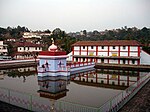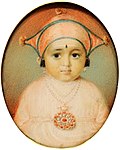Kingdom of Coorg
Kingdom of Coorg | |||||||||
|---|---|---|---|---|---|---|---|---|---|
| Religion | Hinduism | ||||||||
| Government | Monarchy | ||||||||
| Maharaja | |||||||||
| History | |||||||||
• Established | 16th century C.E. | ||||||||
• Disestablished | 1834 | ||||||||
| |||||||||

The Kingdom of Coorg (or Kingdom of Kodagu) was an independent kingdom
Early history
Although Rājendranāme, a royal genealogy of the rulers of
| ||||||||||||||||||||||||||||
Muddu Raja, the Coorg ruler from 1633 to 1687, initially ruled from the town of Haleri, but later moved his capital to
In 1724, major hostilities resumed between Coorg and Mysore.Changing his
The ruler was succeeded by his grandson, Chikka Virappa, whose unremarkable rule lasted until 1768, when Coorg was conquered by
Later history
In 1780, Coorg was invaded by Hyder Ali of Mysore and the state was annexed. For eight years, Coorg was a part of Mysore. In 1788, through British intervention, the Raja of Coorg regained his kingdom. He signed a treaty bringing Coorg under the protection of the British.
From 1790 to 1834, Coorg remained a protectorate of British India. In 1834, the then Raja of Coorg tried to shake off his allegiance to the British which resulted in the Coorg War. The state was eventually annexed and became the Coorg Province.
British rule
Under British rule, the natives of Coorg were encouraged to join the Indian army. Even today most of the soldiers from Karnataka are from this land.
Legacy
The present day Madikeri was formerly known as Muddu raja keri (meaning Mudduraja's town) and was named after the prominent king, Mudduraja who ruled Coorg from 1633-1687. The present day Virajpet derived from Virarajendrapete was the town established by Haleri king Dodda Veerarajendra, after whose name the city derives its name.[9][10]
Chikka Virarajendra was the last ruler of Coorg. Kannada litterateur and Jnanpith Award recipient, Masti Venkatesha Iyengar, wrote a critically acclaimed book, Chikavira Rajendra, based on the life and times of that ruler. King Dodda Veerarajendra built the Nalknad Palace.[9]
Gallery
-
A daughter of Dodda Vira Rajendra
-
Omkareshwara Temple built by King Linga Raja in Madikeri
-
Chikka Vira Rajendra, The last King of Coorg (circa 1805)
-
Princess Gouramma, who would later become Victoria Gouramma, the daughter of Chikka Virarajendra, the last king of Coorg, was adopted to be taken care by Queen Victoria.
References
Citations
- ^ "Portico of the Coorg Rajah's Palace at Somwarpett". The Wesleyan Juvenile Offering: A Miscellany of Missionary Information for Young Persons. X. Wesleyan Missionary Society: 48. May 1853. Retrieved 29 February 2016.
- ^ a b Rice, Benjamin Lewis (1878). Mysore and Coorg, a gazetteer. p. 100. Retrieved 28 June 2018.
- ^ OCLC 980488785.
- ^ Subrahmanyam 1989, p. 212
- ^ a b c Subrahmanyam 1989, p. 99
- ^ Subrahmanyam 1989, pp. 217–218
- ^ a b c Subrahmanyam 1989, pp. 218–219
- ^ Subrahmanyam 1989, p. 220
- ^ a b Mookonda, Kushalappa (10 January 2017). "The set-up of Kodagu's royal cemetery". Deccan Herarld. Retrieved 25 November 2021.
- ^ "On the Haleri trail". No. 17 August 2009. Deccan Herald. Retrieved 28 June 2018.
Bibliography
- Rice, Lewis (1878), "History of Coorg", Mysore and Coorg, A Gazetteer compiled for the Government, Volume 3, Coorg, Bangalore: Mysore Government Press. p. 427
- Subrahmanyam, Sanjay (1989), "Warfare and state finance in Wodeyar Mysore, 1724–25: A missionary perspective", Indian Economic and Social History Review, 26 (2): 203–233, S2CID 145180609
Further reading
- Richter, G (1870). Manual of Coorg- A Gazetteer of the natural features of the country and the social and political condition of its inhabitants. Mangalore: C Stolz, Basel Mission Book Depository. ISBN 9781333863098.
- Government of Coorg (1953), Handbook of Coorg Census-1951 (PDF), Assistant Commissioner and District Census Officer, Coorg





